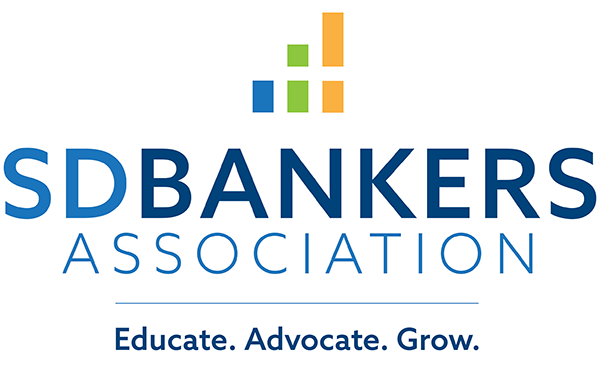- Education & Events
- Advocacy
- Products & Services
- Membership
- Resources
- SDBANKER Magazine
- SDBA eNews
- SDBA eNews Archives
- Legislative Update/Bill Watch
- South Dakota Bank Directory
- Women in Banking
- Scenes of South Dakota Calendar*
- Holiday Signs
- Regulatory Report
- South Dakota Banking Code
- Record Retention Manual
- Advertising & Sponsorship Guide
- COVID-19 Resources
- Mental Health and Crisis Prevention
- About
|
Holiday Signs Available for 2023!The SDBA offers holiday signs that banks can print and display to notify customers when the bank will be closed for the standard holidays. The signs are set up to be printed on 8.5" x 11" paper and are provided as a high-resolution pdf file. Banks can print the signs and use them how they see fit. Virtual Midwest Economic Forecast Forum to be Held on January 12The Midwest Economic Forecast Forum will be held on Thursday, January 12, 2023, from 10:30 a.m. - Noon CT. Prepare for 2023 by joining an economic outlook with St. Louis Fed President James Bullard during this virtual event. Then listen to Augustine Faucher, Chief Economist with the PNC Financial Services Group, as he shares what he expects in 2023 and beyond. Who Should Attend? Community leaders with an interest in the economic and business environment will find value in hearing from our nationally-recognized speakers. Bankers and community leaders are encouraged to invite their business clients to virtually share these economic insights. Individual or group registration rates are available. Registration Information: Registration is available individually or as a group. Take advantage of our group pricing to invite additional staff, business customers, and other community leaders to join you!
Limited sponsorship opportunities are available for this multi-state event. Contact WBA's Nick Loppnow via email for more information. Media Inquiries: For a Media Registration for the event, please contact WBA’s Cassandra Krause at 608-441-1216 or [email protected]. Advance registration is required. Register for the event by clicking here. Virtual Forum Agenda: 10:30 - 11:15 a.m. CT An Economic Discussion with Federal Reserve Bank President James Bullard Time will be allotted for open Q&A. 11:15 a.m. – Noon CT Recession Risks Elevated in 2023 as Fed Raises Interest Rates to Fight Inflation - Augustine (Gus) Faucher 2023 SDBA State Legislative Day to be Held on February 15The SDBA State Legislative Day on Feb. 15, 2023, at the Ramkota Hotel & Conference Center in Pierre is your opportunity to stay up-to-date on both state and federal legislation which could affect the banking industry, visit with state legislators and constitutional officers, and make sure our industry is heard. The day will include an SDBA Legislative Committee meeting, lunch, SDBA update, featured speaker James Nowak, Gov. Kristi Noem (invited), the chance to visit with state legislators at the State Capitol, and an evening reception with state legislators and constitutional officers. The day will also include special sessions specifically designed for emerging industry leaders. Registration Open for Breaking into Banking 101: Fundamentals of Commercial BankingThe SDBA will hold Breaking into Banking 101: Fundamentals of Commercial Banking virtually on February 23, 2023. This ten-module course is most appropriate for new credit analysts, lenders, and underwriters, as well as bankers who don’t do credit analysis but need a working knowledge of the process. This may include statement spreaders, loan processors and closers, treasury management associates, administrative support for credit or lending officers, branch managers, and interns. Learn more and register. The Power of Employee Financial Literacy: Growing Bank Business by Empowering and ElevatingThe banking industry is more complex than ever before, shifting to digital and reinventing itself to satisfy customers’ rising expectations for more convenient access. With threats of looming economic hardships and increased competition to contend with, banks are working overtime to not only adapt and evolve, but also to seize competitive advantages. They need all hands on deck. And employees play a key part in this equation. A powerful way to support employees and empower them to take on greater, more strategic roles is to ensure that they understand the bank’s financial health and progress towards strategic goals. While it’s often assumed that professionals, especially those working for financial institutions, are well in tune with financial metrics, they may be unaware of the strategic priorities that drive their organization’s financial results. Providing transparency and helping employees understand the significance of financial results and the key performance indicators that drive them can enhance their productivity, engagement and overall job satisfaction, resulting in a stronger business. Here are some ways to support the banking business by shedding light on its vernacular and maximizing employee contributions through financial literacy: Share game-changing knowledge. The Milken Institute reviewed and analyzed numerous studies and surveys for a better understanding of the financial literacy of Americans, landing on a troublesome finding: “Many individuals in the U.S.— both young and old—lack the basic knowledge and skills required to navigate today’s complex financial world successfully.” While those who work in banking are arguably more financially savvy, many can benefit from revisiting a training course on finance and its importance within their institution. Bank leaders should encourage and empower their financial teams, including accounting, financial planning and analysis teams, to share basic financial education throughout the bank. New hire onboarding and training and regular team meetings are excellent places to distill information throughout the organization. Company-wide meetings are another avenue to celebrate internal goals and provide employees with an opportunity to tie successes with financial objectives and milestones, bringing the numbers to life. Rather than inundating employees with too many details, leaders should focus on result metrics that matter to the banking business. In addition to revenue, expenses and operating profit, which are critical to all types of businesses, highlight the importance of assets under management, the market value of the assets the financial institution manages on behalf of its clients or investors. By explaining what this means and why a high AUM is an important indicator of success, bank employees can better understand how the institution makes money and how their work correlates. Dive deeper into the KPIs of successful banking. When it comes to helping employees understand how the bank monitors its financial health, focus on a few important KPIs, including loans, deposits and non-interest income. Looking at the loan-deposit ratio can help teams understand the bank’s liquidity, while understanding non-interest income can help to explain how the bank maintains its profit margins. Providing visibility and a clear understanding of these metrics ensures that the primary emphasis in financial discussions is focused on what teams can control. It’s also important to simplify and explain the institution’s business model to help teams make sense of the financials. Some companies use a flywheel analogy from the popular business book “Good to Great.” The model distills business down to four simple gears, providing an effective narrative that helps people understand how their work and costs align, as well as where their department fits within the model. Foster a transparent culture to earn trust and enhance engagement. Transparency can be a tough ask for banks. They are stewards of highly sensitive information and face complex regulations. Fortunately, banks can adhere to financial disclosure policies and still provide the transparency needed to earn their employees’ trust. One way to earn trust is to establish an open, transparent culture. By sharing the bank’s financials and distilling their significance with employees, banks can create a common language and a platform for reiterating the organization’s core messages and objectives. Maintaining clear lines of communication for business updates between c-suite leaders, team executives and employees also aids engagement and can also minimize potentially harmful employee hearsay. An open, engaged workplace goes a long way in helping banks retain talent. When employees feel a part of the bigger picture and understand the importance of their contribution, they are less likely to look for another job. An open culture is also helpful for attracting new hires, aiding banks confront with troubling staffing challenges and labor shortages that are can threaten growth. Empower teams to think like CFOs. Bankers can easily get caught up in managing through spreadsheets when they could be making more strategic contributions to help their organizations through troubling times. Executing strategies to persistently share the dialect of the banking business and make sense of its unique KPIs and financial reports will encourage employees across all departments to take a more strategic view of their work. Banks will reap the benefits, from better analyzing and risk management to higher efficiency. As well as more engaged employees. View the original article shared by the ABA.
Top Cybersecurity Trends to Watch for in 2023It’s no secret that the cybersecurity landscape is constantly evolving. New threats are emerging all the time, and existing threats are becoming more sophisticated. This makes it critical for organizations to stay ahead of the curve and ensure they are prepared to deal with the latest security challenges. In this article from the United States Cybersecurity Magazine, they explore 9 of the most important cybersecurity trends that organizations need to be aware of in 2023.
Happy New Year from the SDBA!The SDBA will be closed in observance of the New Year holiday on Monday, January 2. We'll re-open at 8 a.m. CT on Tuesday, January 3. We are looking forward to 2023 and we wish you a wonderful start to the new year!
|


